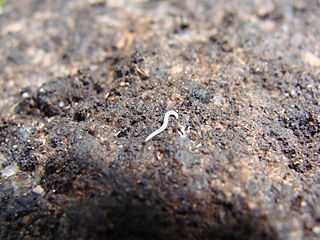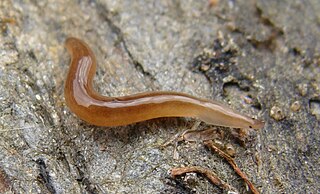
Dugesia is a genus of dugesiid triclads that contains some common representatives of the class Turbellaria. These common flatworms are found in freshwater habitats of Africa, Eurasia, and Australia. Dugesia is best known to non-specialists because of its regeneration capacities.

Planariidae is a family of freshwater planarians.

Geoplanidae is a family of flatworms known commonly as land planarians or land flatworms.

Continenticola is a clade that includes the land planarians (Geoplanidae) and the freshwater triclads.

Girardia is a genus of freshwater planarians belonging to the family Dugesiidae.

Schmidtea is a genus of freshwater triclads. Species of the genus Schmidtea are widely used in regeneration and developmental studies.
Dugesia notogaea is a species of dugesiid triclad that inhabits freshwater bodies of north Queensland, Australia.

Dugesia aenigma is a species of dugesiid triclad that inhabits freshwater bodies of Cephalonia, Greece.
Dugesia sicula is a species of dugesiid triclad that lives in freshwater bodies of the Mediterranean Basin, where it is widely distributed. It has been reported from Sicily, Elba and Mallorca, Eivissa, Sardinia, Algeria, Tunisia, Morocco and Crete.

Geoplanoidea is a superfamily of freshwater and land triclads that comprises the species of the Geoplanidae and the Dugesiidae families.

Kenkiidae is a family of freshwater triclads. Their species can be found sporadically in caves, groundwater, and deep lakes in Central Asia, Far East and North America.
Cura is a genus of freshwater flatworm (triclad)s belonging to the family Dugesiidae.

Microplana is a genus of land planarians found in Europe and Africa.

Microplaninae is a subfamily of land planarians.
Neppia is a genus of dugesiid triclad that is found in South America, Subantarctic region, Africa, Tasmania and New Zealand.

Geoplaninae is a subfamily of land planarians endemic to the Neotropical region. Members of this family are sometimes referred to as the Neotropical land planarians. However, one species, Obama nungara has been introduced in Europe.

The reproductive system of planarians is broadly similar among different families, although the associated structures can vary in complexity.

Dugesia subtentaculata is a species of planarian that inhabits the freshwater of Southern France, several localities on the Iberian Peninsula, Mallorca, Morocco and Algeria.

Rhynchodeminae is a subfamily of land planarians with a worldwide distribution.

Caenoplanini is a tribe of land planarians in the subfamily Rhynchodeminae mostly found throughout the Australasian and Oceanian realms.













